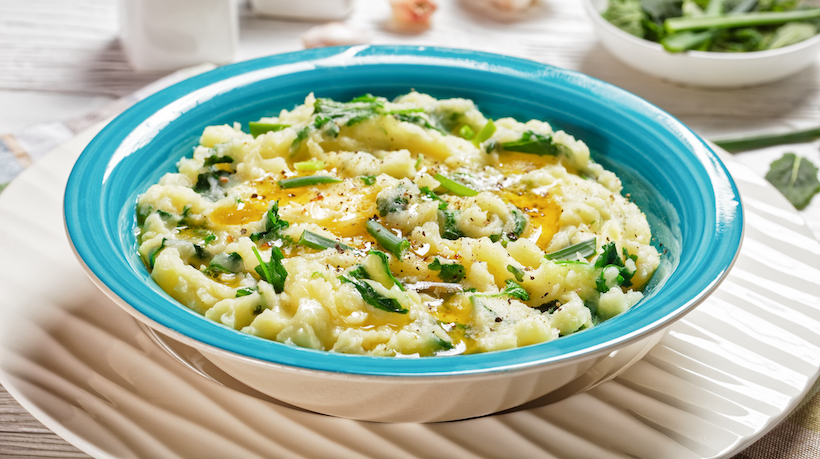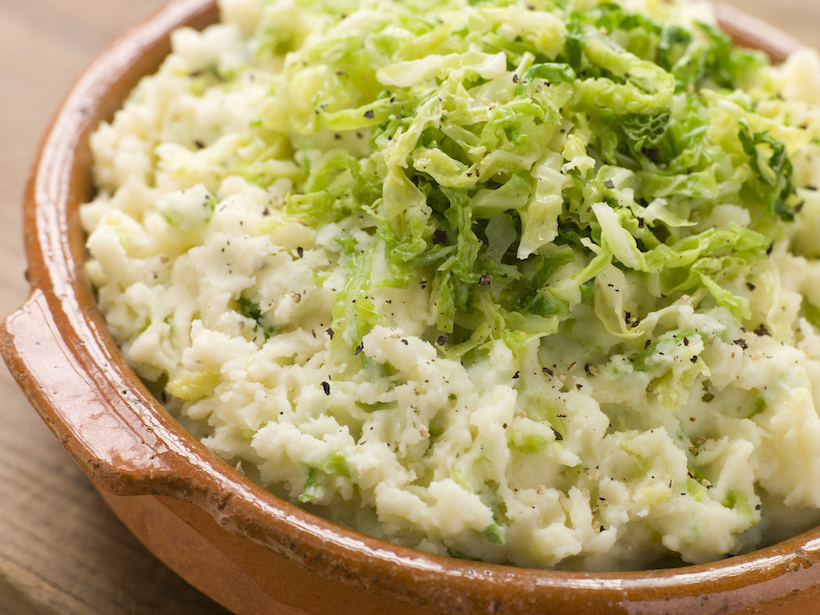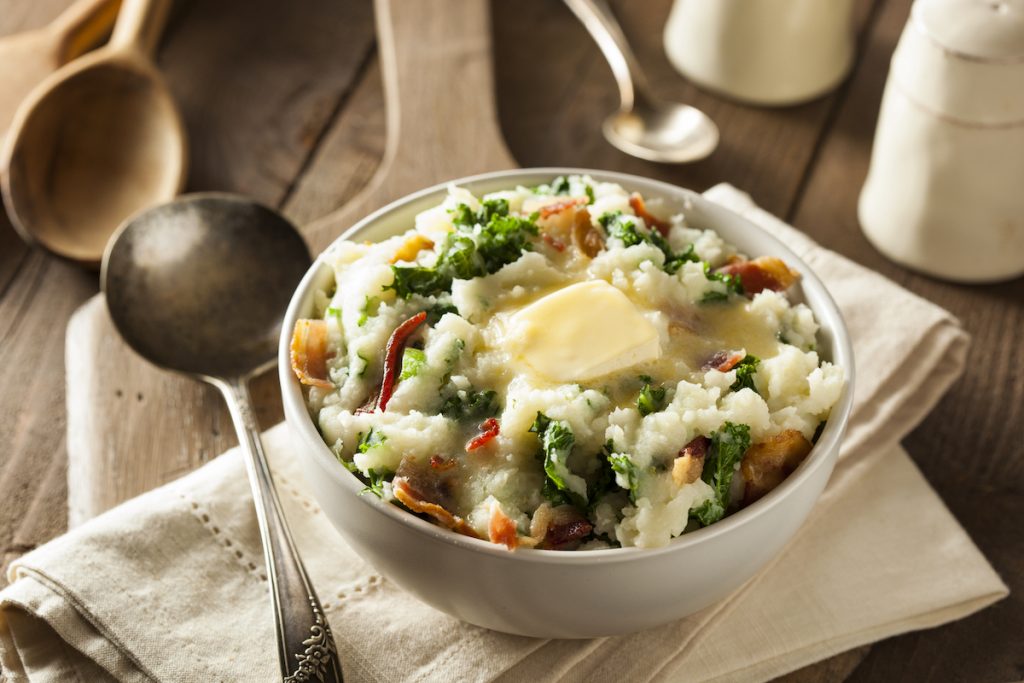You can find steaming batches of colcannon in homes across the U.S. every St. Patrick's Day as people celebrate Irish culture with this traditional dish. But in Ireland, Colcannon is more often associated with Halloween than St. Patrick's Day – and is used as a fortune-telling device often along with a meal.
Fun stuff, and tasty too – let's take a look at colcannon's history and find out how this Irish staple came to be.

At first glance, colcannon might seem pretty simple. Colcannon is a simple yet satisfying Irish potato dish that's often eaten during holidays.
In terms of the dish itself, that's absolutely right. Colcannon contains only the following ingredients:
To make it, boil and mash the potatoes; boil, steam, or sweat the greens; and mix everything together. Garlic and spring onions are common additions that give the dish a kick, and if you're craving something extra mouthwatering, place a tablespoon or two of melted butter on top.
But colcannon is much more than mashed potatoes. The dish goes back hundreds of years, providing sustenance to the working poor, home cooking comfort to families, and the joy of celebration during holidays. And like four-ingredient soda bread, there's beauty in the simple dish.
As with most words derived from classical languages, the exact root of the word "colcannon" is up for debate. That said, there are two main theories, both of which might make sense – let's look at both in turn.
"Cal ceannann" is a Gaelic phrase that means white-headed or white-faced cabbage, so some suggest that the "white" refers to potatoes mixed with cabbage.
Another theory proposes that the word colcannon comes from the old Irish words "cal," which means cabbage, and "cainnenin," which can mean garlic, onion, or leek.
If this theory is accurate, it suggests that the dish may have origins that predate the potato's arrival to Ireland.
Colcannon has long been a part of Halloween in Ireland, during which fortune-telling foods are popular – along with early takes on the Jack O'Lantern.
Kind of like coins and plastic babies in king cake, series of items get mixed in with the colcannon, and each item contains a specific meaning for the diner who receives it:
The items used and their meanings vary from region to region.
In some homes, hopeful maidens fill a sock with colcannon and hang it from the front door in the hopes that the next bachelor who walks through will marry them.

Colcannon has been around for hundreds of years. But how did it come to be?
Cabbage was a large part of ancient Roman, Egyptian, and Greek diets at least as far back as the 4th century B.C. Most scholars credit the ancient Romans with bringing the cabbage to Europe as their empire expanded. However, there are several varieties of brassica, leafy green plants, native to Europe, so it's hard to pinpoint precisely when cabbage as we know it came to be.
Making the matter more confusing, the Celts had words for cabbage as far back as the Iron Age and are very likely to have introduced the vegetable to Europe and Ireland long before the Romans did.
Regardless of who first introduced the plant, it's clear that the Irish have been cultivating and eating cabbage for thousands of years.
The potato is native to Peru and made its way to Europe in the late 1500s as global trading expanded.
The tuber is hardy and easy to grow, making it an inexpensive food item. It's also substantial, so it's ideal for those who need to stave off hunger with little food. These characteristics quickly made potatoes a valuable food source across Europe, preventing starvation for many.
Many historians credit Sir Walter Raleigh with introducing the potato to Ireland in the 1600s, but that seems to be based on myth rather than fact. It was more likely brought to Ireland by Spanish trade ships, based on the evidence available.
Potatoes were a primary dietary staple for the poor and working-class in Ireland—so much so that when a fungal infection wiped out potato crops from 1845-1852, it led to what historians call the Irish Potato Famine. Around a million people starved to death, and millions more left the country as refugees during this time. Now that potato crops are again healthy, potatoes have returned to the table as a staple in Irish cooking.
The first written mention of colcannon was in the diary of William Bulkeley, who was visiting Ireland from Wales in 1735. Recipes from about a hundred years later show that colcannon was as popular as ever, often served alone as breakfast or as a side dish along with meat.
Halloween descended from the ancient Gaelic festival Samhain. Some believe that the boundaries between the living worlds and the otherworldly are open during this day, making it easier for the dead and supernatural to pass messages to the living.
For this reason, many historical Irish Halloween celebrations involve fortune-telling games, such as the one described above using colcannon. Fortune telling has been a part of Irish Halloween traditions for at least 2,000 years, which is something to think about next time you're eating your Halloween colcannon.
When you consider that over a third of American immigrants from 1820 to 1860 were Irish, it makes sense that Irish traditions and recipes would come with them. Many Irish immigrants continued making colcannon as a way to fill up when money was tight and as a way to remember better times back home.
In 1737, a group of Irish immigrants staged the first large-scale St. Patrick's Day parade in Boston, Massachusetts. St. Patrick's Day was generally considered a somber religious holiday in Ireland. As the years went on, celebrating St. Patrick's Day in America became synonymous with corned beef, Irish pride, and all things Irish – and yes, green beer. Eventually, non-Irish citizens began joining in, taking up aspects of Irish culture, such as colcannon, to celebrate.
Colcannon is as popular today as it ever was and really hasn't changed much over the years.
The dish can be eaten alone as a meal, though it's often served as a side dish along with:
Colcannon has always varied between regions and households, so it's common to see people put their spin on it by packing it into molds and baking it or shaping it into patties to fry for breakfast.
There are even recipes for "loaded" colcannon, which include the addition of bacon and cheese to the already hearty dish.

Like other classic Irish dishes, there isn't too much complication to colcannon. With four ingredients in its most basic form, it's still hearty and satisfying.
As a dish – whether on St. Patrick's, Halloween, or any other day – it's a great way to pay homage to Ireland and share a tradition through the year. I hope you enjoyed the post, and more importantly, I hope you enjoy your colcannon.